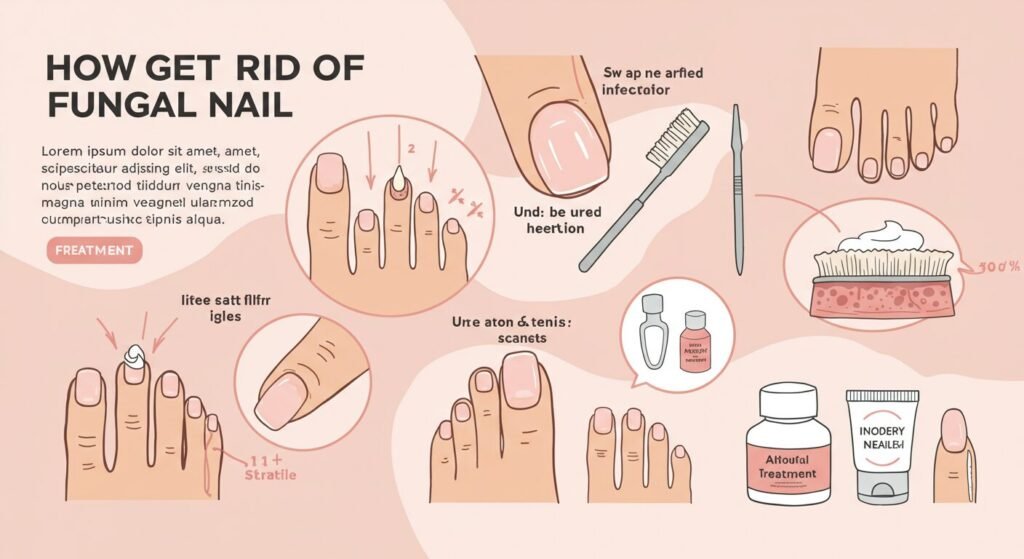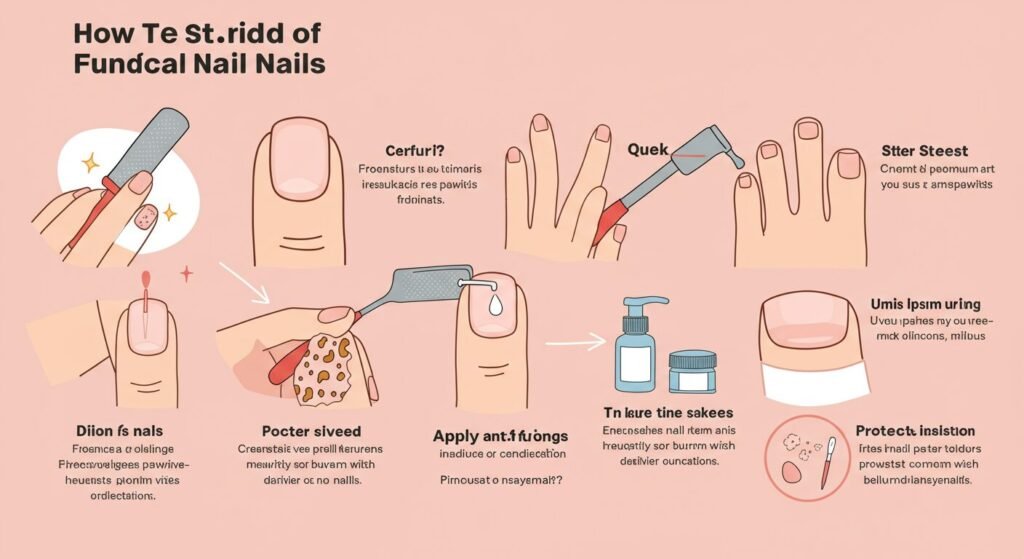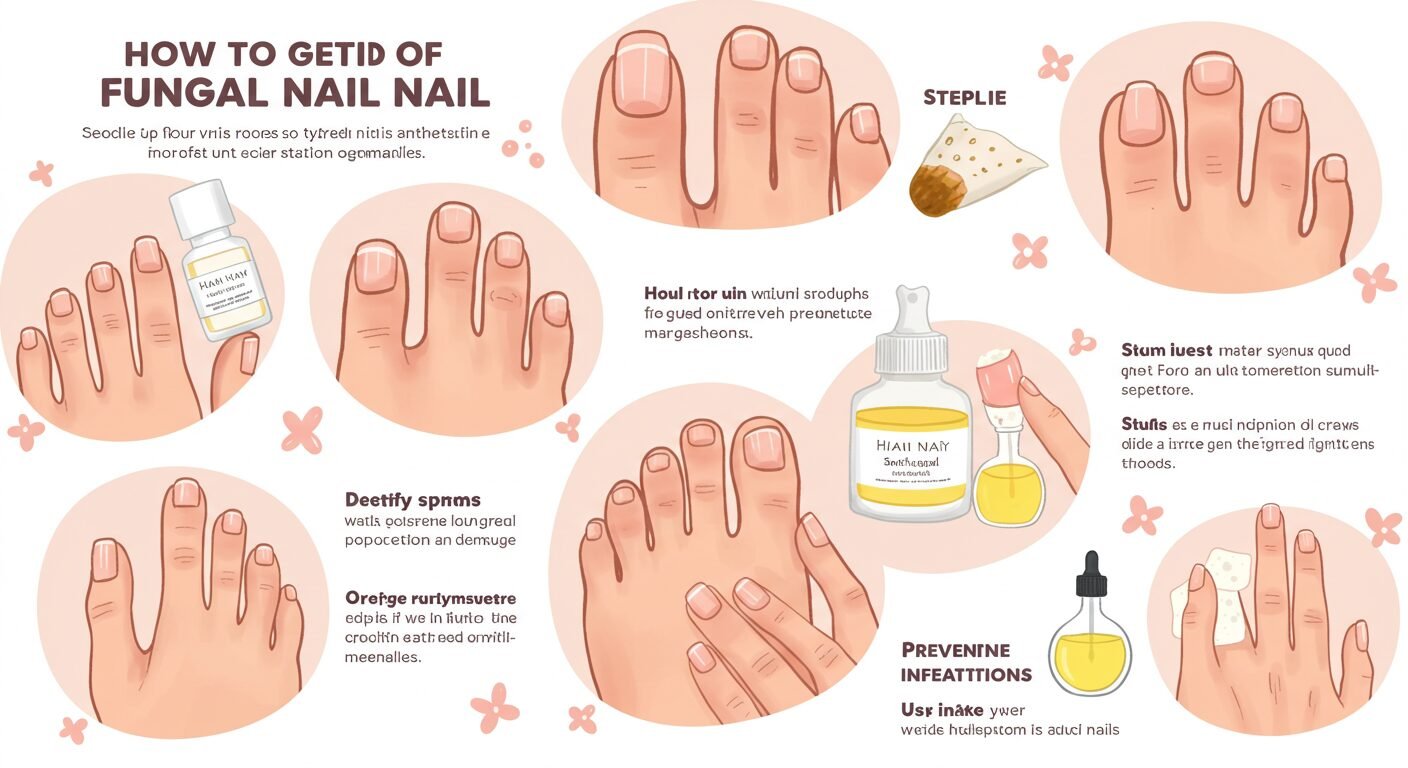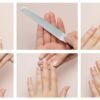Are you struggling with unsightly, thickened, or discolored nails that won’t seem to improve no matter what you try? You’re dealing with one of the most persistent and frustrating nail conditions – fungal nail infection. Learning how to get rid of fungal nail effectively requires understanding the condition, choosing appropriate treatments, and maintaining consistent care routines.
Nail fungus treatment has evolved significantly in recent years, offering both medical and natural solutions that can help restore healthy, beautiful nails. Whether you’re dealing with toenail fungus or fingernail fungus, the right approach combines proven treatments with lifestyle modifications that prevent reinfection.
This comprehensive guide explores everything from over-the-counter remedies to prescription treatments, natural alternatives, and prevention strategies that will help you reclaim healthy, attractive nails and prevent future fungal infections.
Understanding Fungal Nail Infections
What Is Nail Fungus?
Fungal nail infection, medically known as onychomycosis, occurs when fungi penetrate the nail bed and nail plate, causing progressive damage to nail structure and appearance. Nail fungus causes include dermatophyte fungi, yeasts, and molds that thrive in warm, moist environments.
Fungal infection types vary based on the causative organism, with dermatophytes being the most common culprits affecting both fingernails and toenails. Nail fungus symptoms develop gradually and include thickening, discoloration, brittleness, and sometimes complete nail destruction.
Infection progression typically starts at nail edges or tips and slowly spreads toward the cuticle area, making early treatment crucial for preventing extensive damage and difficult-to-treat infections.
Risk Factors and Causes
Fungal nail risk factors include age (higher risk after 60), diabetes, compromised immune systems, circulation problems, and history of athlete’s foot. Environmental factors like frequent exposure to moisture, tight-fitting shoes, and communal shower use increase infection likelihood.
Nail trauma from injuries, aggressive manicures, or ill-fitting footwear creates entry points for fungal organisms. Genetic predisposition may make some individuals more susceptible to fungal infections than others.
Lifestyle factors including poor foot hygiene, synthetic sock materials, and inadequate shoe ventilation create conditions that promote fungal growth and infection development.
Recognizing Symptoms and Early Signs
Visual Identification
Nail fungus appearance varies but commonly includes yellow, brown, or white discoloration that starts at nail edges and spreads inward. Nail thickening occurs as fungus disrupts normal nail growth patterns and cellular structure.
Surface changes include roughness, crumbling, or flaking that makes nails appear unhealthy and damaged. Shape distortion may develop as infection progresses, causing nails to become curved, twisted, or misshapen.
Debris accumulation under nails is common as fungal organisms multiply and create waste products that collect beneath nail plates, causing foul odors and further discoloration.
Physical Symptoms
Nail brittleness increases as fungal infection weakens nail structure, leading to easy breakage, splitting, or crumbling during normal activities. Pain and discomfort may develop in advanced cases, especially with toenail infections.
Surrounding skin changes include redness, swelling, or irritation around infected nails as the body attempts to fight the fungal invasion. Secondary bacterial infections can occur when damaged nails allow bacteria to enter.
Functional impairment may result from severely thickened or distorted nails that interfere with shoe fitting, walking comfort, or manual dexterity for fingernail infections.
Medical Treatment Options

Prescription Medications
Oral antifungal medications like terbinafine (Lamisil) and itraconazole (Sporanox) represent the most effective treatments for severe fungal nail infections. Systemic treatment works from inside the body to eliminate fungus throughout the nail structure.
Topical prescription treatments include ciclopirox (Penlac) nail lacquer and efinaconazole (Jublia) solution that penetrate nail plates to reach fungal organisms. Combination therapy using both oral and topical medications may provide enhanced effectiveness.
Treatment duration for prescription medications typically ranges from 3-12 months, with oral treatments often requiring 6-12 weeks of medication followed by months of nail regrowth observation.
Professional Procedures
Laser therapy uses focused light energy to heat and destroy fungal organisms within nail structures without damaging surrounding healthy tissue. Photodynamic therapy combines light treatment with photosensitizing agents for enhanced fungal elimination.
Surgical nail removal may be recommended for severe infections that don’t respond to other treatments, allowing direct access to infected nail bed tissue for treatment application.
Chemical nail removal using urea compounds offers less invasive alternatives to surgical procedures while still allowing intensive treatment of underlying infected areas.
Over-the-Counter Treatment Solutions
Antifungal Products
OTC antifungal creams containing ingredients like clotrimazole, miconazole, or undecylenic acid provide accessible treatment options for mild to moderate infections. Antifungal nail polishes offer convenient application methods for consistent treatment.
Medicated nail files impregnated with antifungal agents help remove infected nail material while delivering treatment directly to affected areas. Antifungal powders help maintain dry conditions that discourage fungal growth.
Treatment effectiveness varies significantly among over-the-counter options, with some individuals experiencing good results while others require prescription-strength medications for infection clearance.
Application Guidelines
Proper application technique involves cleaning and drying nails thoroughly before applying treatments, following manufacturer instructions for frequency and coverage areas. Consistency requirements demand daily application for weeks or months to achieve results.
Treatment monitoring helps track progress and determine when to seek professional medical evaluation for persistent or worsening infections despite consistent home treatment efforts.
Combination approaches using multiple OTC products simultaneously may enhance effectiveness but should be discussed with healthcare providers to avoid adverse interactions or excessive irritation.
Natural and Home Remedies
Tea Tree Oil Treatment
Tea tree oil antifungal properties make it a popular natural treatment option with documented effectiveness against various fungal organisms. Application methods include direct application of diluted oil or combining with carrier oils for sensitive skin.
Concentration guidelines recommend using 5-10% tea tree oil solutions to balance effectiveness with skin tolerance, as higher concentrations may cause irritation or allergic reactions in sensitive individuals.
Treatment consistency requires twice-daily application for several months to see significant improvement, with gradual nail clearing occurring as new, healthy nail growth replaces infected areas.
Vinegar Soaks
Apple cider vinegar and white vinegar create acidic environments that may help inhibit fungal growth while softening infected nail material for easier removal. Soaking protocols typically involve 20-30 minute sessions several times weekly.
Dilution ratios of one part vinegar to two parts warm water provide effective treatment concentrations while minimizing skin irritation from prolonged acid exposure.
Enhanced effectiveness may result from combining vinegar soaks with mechanical removal of softened infected nail material using sterile files or pumice stones.
Other Natural Approaches
Baking soda treatments create alkaline conditions that may help neutralize fungal growth while absorbing moisture that fungi need for survival. Garlic extract applications utilize natural antifungal compounds found in fresh garlic cloves.
Essential oil combinations incorporating oregano oil, lavender oil, or thyme oil may provide synergistic antifungal effects when properly diluted and consistently applied to infected nails.
Coconut oil massage provides moisturizing benefits while delivering caprylic acid and lauric acid compounds that demonstrate natural antifungal properties in laboratory studies.
Treatment Combinations and Protocols
Integrated Approach Benefits
Combination therapy using multiple treatment modalities simultaneously may provide enhanced effectiveness compared to single-treatment approaches for stubborn or extensive infections. Synergistic effects can result from combining different antifungal mechanisms.
Medical supervision becomes important when combining prescription medications with other treatments to ensure safety and avoid adverse interactions or excessive skin irritation.
Staged treatment protocols might begin with conservative approaches and progress to more aggressive treatments based on response and infection severity over time.
Treatment Scheduling
Daily routine development helps ensure consistent application of treatments while allowing adequate time for each product to work effectively without interference from subsequent applications.
Timing considerations include applying treatments when feet will remain dry and protected, typically before bedtime or during extended periods of shoe-free time.
Progress monitoring schedules help track improvement and determine when modifications to treatment protocols might be necessary for optimal results.
Prevention Strategies and Lifestyle Changes

Hygiene Practices
Daily foot care routines including thorough washing, complete drying, and inspection help prevent conditions that promote fungal growth and early detection of potential problems.
Nail trimming techniques using clean, sharp instruments and proper cutting angles prevent trauma that creates entry points for fungal organisms. Sanitization protocols for nail care tools prevent cross-contamination between infected and healthy nails.
Moisture control through proper drying, breathable footwear choices, and antifungal powders creates environments hostile to fungal growth and multiplication.
Environmental Modifications
Shoe hygiene involves regular cleaning, drying, and rotation of footwear to prevent fungal buildup in warm, moist environments. Sock selection favoring moisture-wicking materials over synthetic fabrics that trap humidity.
Home environment control includes maintaining low humidity levels, ensuring bathroom ventilation, and using antifungal sprays in areas where fungal contamination might occur.
Public space precautions involve wearing protective footwear in gyms, pools, locker rooms, and other communal areas where fungal exposure risk is elevated.
Diet and Lifestyle Factors
Nutritional Support
Immune system strengthening through proper nutrition helps the body fight fungal infections more effectively. Antifungal foods including garlic, coconut oil, and probiotics may provide internal support for external treatments.
Sugar reduction in diet helps create less favorable conditions for fungal growth throughout the body, including nail infections. Hydration maintenance supports healthy circulation that aids in infection fighting.
Vitamin and mineral supplementation particularly zinc, vitamin D, and biotin may support nail health and immune function during treatment periods.
Lifestyle Modifications
Stress management helps maintain strong immune function that supports the body’s ability to fight fungal infections effectively. Exercise routines that promote circulation may aid in treatment effectiveness.
Sleep quality impacts immune function and healing capacity, making adequate rest important during treatment periods. Smoking cessation improves circulation and immune function that support infection recovery.
Diabetes management becomes crucial for diabetic individuals, as blood sugar control directly affects infection fighting ability and healing rates.
When to Seek Professional Help
Medical Consultation Indicators
Treatment failure after 2-3 months of consistent home treatment suggests need for professional evaluation and potentially stronger prescription medications. Worsening symptoms including increased pain, swelling, or spreading infection require immediate medical attention.
Diabetic complications make professional medical supervision essential due to increased risks of serious infections and healing complications. Immune system concerns in individuals with compromised immunity require specialized medical management.
Multiple nail involvement or extensive infection may require systemic treatment approaches only available through medical prescription and supervision.
Specialist Referrals
Dermatologist consultation provides specialized expertise in fungal infections and access to advanced treatment options including newer prescription medications and procedures.
Podiatrist evaluation offers foot-specific expertise particularly valuable for toenail infections complicated by biomechanical issues or diabetic concerns. Laboratory testing can identify specific fungal organisms and guide targeted treatment approaches.
Infectious disease specialists may be consulted for resistant infections or patients with complex medical histories that complicate treatment planning and execution.
Treatment Timeline and Expectations
Realistic Recovery Expectations
Treatment duration for fungal nail infections typically requires 6-18 months due to slow nail growth rates and deep fungal penetration into nail structures. Gradual improvement occurs as new, healthy nail growth replaces infected areas from cuticle outward.
Toenail recovery takes longer than fingernail treatment due to slower growth rates, with complete clearance often requiring 12-18 months of consistent treatment and monitoring.
Patience requirements during treatment help maintain motivation and treatment compliance during extended recovery periods that test commitment to consistent care routines.
Progress Monitoring
Monthly assessment of nail appearance, thickness, and discoloration helps track treatment effectiveness and guide decisions about continuing or modifying treatment protocols.
Photography documentation provides objective records of improvement that may be difficult to perceive during gradual daily changes throughout extended treatment periods.
Professional check-ups during treatment help ensure proper progress and allow adjustments to treatment plans based on response and any developing complications or side effects.
Common Treatment Challenges
Resistance and Recurrence
Treatment resistance may develop due to inadequate treatment duration, inconsistent application, or inherent fungal resistance to specific antifungal agents being used.
Reinfection prevention requires ongoing vigilance and maintenance of environmental controls even after successful treatment to prevent new fungal exposure and infection development.
Biofilm formation by some fungal organisms creates protective barriers that reduce treatment penetration and effectiveness, requiring specialized treatment approaches or extended therapy duration.
Side Effects Management
Medication side effects from oral antifungals may include liver function changes, gastrointestinal upset, or skin reactions that require monitoring and potential treatment modifications.
Topical irritation from strong antifungal preparations may cause redness, burning, or contact dermatitis that necessitates treatment adjustments or alternative approaches.
Cost considerations for extended treatment periods may impact treatment compliance and require discussion of cost-effective alternatives or insurance coverage options.
Special Populations and Considerations
Elderly Patients
Age-related factors including slower nail growth, circulation issues, and multiple medications may complicate treatment planning and require modified approaches for optimal results.
Mobility limitations may affect ability to perform daily foot care routines or apply treatments consistently, requiring assistance or simplified treatment protocols.
Multiple health conditions common in elderly populations may contraindicate certain treatments or require careful coordination between healthcare providers managing various conditions.
Diabetic Patients
Infection risks are significantly elevated in diabetic individuals, making prompt, aggressive treatment essential to prevent serious complications including tissue death or amputation.
Healing complications due to poor circulation and compromised immune function require close medical supervision throughout treatment periods with frequent monitoring for complications.
Foot care education becomes critical for diabetic patients to prevent injuries that could lead to serious infections or interfere with fungal treatment success.
Alternative and Complementary Therapies
Physical Therapies
UV light therapy using germicidal wavelengths may help eliminate fungal organisms on nail surfaces, though penetration into deep nail structures remains limited.
Ozone therapy applications claim antifungal benefits, though scientific evidence for effectiveness remains limited and treatment availability is restricted in many areas.
Cold laser therapy represents newer treatment approaches with some promising results, though more research is needed to establish optimal protocols and effectiveness rates.
Herbal and Botanical Treatments
Neem oil applications utilize traditional antifungal properties found in neem tree extracts, though concentration and preparation methods significantly affect effectiveness.
Pau d’arco extract contains compounds with documented antifungal activity, though topical application methods and effectiveness for nail infections require further study.
Calendula preparations may provide anti-inflammatory benefits that support healing while other antifungal treatments address the underlying fungal infection directly.
Long-Term Management and Maintenance
Preventing Reinfection
Environmental control continues to be important after successful treatment, including ongoing shoe hygiene, moisture management, and protective measures in high-risk environments.
Regular monitoring for early signs of reinfection allows prompt treatment initiation before infections become established and difficult to treat again.
Maintenance treatments using antifungal powders, periodic topical applications, or protective measures may be recommended for individuals at high risk of reinfection.
Nail Health Optimization
Ongoing nail care routines that promote healthy nail growth and early problem detection help maintain treatment results and prevent future infections.
Professional maintenance through regular podiatry visits may be beneficial for individuals with risk factors or history of recurrent fungal infections.
Health optimization addressing underlying conditions that increase fungal infection risk helps maintain long-term nail health and reduces reinfection likelihood.
Cost Analysis and Treatment Economics
Treatment Cost Comparison
Over-the-counter costs for extended treatment periods may accumulate significantly over months of consistent use, sometimes exceeding prescription medication costs.
Prescription medication expenses vary widely based on insurance coverage, generic availability, and treatment duration requirements for complete infection clearance.
Professional procedure costs including laser therapy or surgical interventions represent significant investments but may provide more rapid or complete results for severe infections.
Cost-Effectiveness Considerations
Treatment success rates should be weighed against costs when choosing between different treatment approaches, considering both immediate expenses and potential costs of treatment failure.
Quality of life impacts from persistent fungal infections may justify higher treatment costs for more effective therapies that provide faster or more complete results.
Prevention investments in proper footwear, hygiene products, and environmental controls may provide excellent returns by preventing costly future infections and treatments.
Research and Future Developments
Emerging Treatment Options
Novel antifungal agents in development may offer improved effectiveness or reduced side effects compared to current treatment options for resistant or recurrent infections.
Drug delivery innovations including better nail penetration methods may improve topical treatment effectiveness and reduce reliance on oral medications with systemic side effects.
Combination therapy research explores optimal protocols for using multiple treatment approaches simultaneously for enhanced effectiveness and reduced treatment duration.
Technology Applications
Diagnostic improvements including rapid fungal identification may allow more targeted treatment approaches and better prediction of treatment success rates.
Treatment monitoring technology may provide better objective measures of treatment progress and guide decisions about continuing or modifying treatment protocols.
Prevention technologies including antifungal materials and environmental controls may help reduce infection rates and support treatment maintenance efforts.
Psychological and Social Aspects
Quality of Life Impact
Appearance concerns from fungal nail infections may affect self-confidence, social interactions, and willingness to participate in activities involving foot exposure.
Treatment burden from extended treatment periods and daily care routines may impact quality of life and treatment compliance over time.
Social stigma associated with fungal infections may cause embarrassment or isolation that affects mental health and treatment motivation.
Coping Strategies
Support systems including healthcare providers, family, and online communities may help maintain treatment motivation during extended recovery periods.
Cosmetic solutions like nail polish or artificial nails may provide temporary appearance improvements while underlying treatment progresses, though some approaches may interfere with treatment effectiveness.
Activity modifications during treatment may be necessary to prevent reinfection while maintaining active lifestyles and social engagement as much as possible.
Conclusion
Successfully getting rid of fungal nail infections requires a comprehensive approach that combines effective treatment methods with consistent care routines and lifestyle modifications. While the process can be lengthy and challenging, understanding your options and maintaining realistic expectations significantly improves your chances of achieving healthy, attractive nails.
The most important factor in fungal nail treatment success is consistency. Whether you choose medical treatments, natural remedies, or combination approaches, daily commitment to your treatment protocol makes the difference between success and continued frustration with persistent infections.
Remember that fungal nail infections are common, treatable conditions that millions of people successfully overcome each year. With patience, proper treatment selection, and consistent application of proven methods, you can restore healthy nail appearance and function while preventing future infections.
Don’t let embarrassment prevent you from seeking appropriate treatment or professional guidance when needed. Healthcare providers are experienced in treating fungal nail infections and can provide valuable guidance for selecting the most appropriate treatment approach for your specific situation and health status.
Your journey to healthy nails begins with taking the first step toward consistent, appropriate treatment. With the knowledge and strategies outlined in this guide, you’re equipped to make informed decisions and maintain the motivation necessary for successful fungal nail infection treatment and long-term nail health.
Frequently Asked Questions
How long does it take to get rid of a fungal nail infection?
Fungal nail infection treatment typically takes 6-18 months for complete clearance, depending on infection severity and treatment method used. Toenail infections generally take 12-18 months due to slower nail growth, while fingernail infections may clear in 6-9 months. Oral prescription medications often show results in 3-6 months, but complete nail clearance requires waiting for healthy nail regrowth. Consistent daily treatment and patience are essential for success.
What is the most effective treatment for nail fungus?
Oral antifungal medications like terbinafine (Lamisil) are considered most effective for severe infections, with success rates of 70-80%. For mild infections, topical prescription treatments like efinaconazole may be sufficient. Laser therapy shows promising results but requires multiple sessions. Combination approaches using both oral and topical treatments may provide the highest success rates. Treatment effectiveness varies based on infection severity, nail involvement, and individual response factors.
Can nail fungus go away on its own without treatment?
Nail fungus rarely resolves without treatment and typically worsens over time if left untreated. The infection tends to spread to other nails and may cause permanent nail damage or deformity. Early, mild infections occasionally improve with aggressive hygiene measures, but established infections require active antifungal treatment. Waiting for spontaneous resolution usually results in more extensive infection requiring longer, more intensive treatment to achieve clearance.
Are natural remedies effective for treating nail fungus?
Some natural remedies like tea tree oil and vinegar soaks show modest effectiveness for mild infections, but success rates are generally lower than prescription treatments. Natural approaches work best as supportive treatments alongside medical therapy or for prevention after successful treatment. While safer than medications, natural remedies require longer treatment periods and may not penetrate deeply enough for severe infections. Combining natural approaches with medical treatment often provides the best results.
How can I prevent nail fungus from coming back after treatment?
Prevent reinfection by maintaining good foot hygiene, keeping nails dry, wearing breathable shoes and moisture-wicking socks, and using antifungal powders. Avoid walking barefoot in public areas, disinfect shoes and nail tools regularly, and replace old shoes that may harbor fungal spores. Continue using antifungal products intermittently even after clearance, especially in high-risk situations. Address underlying conditions like diabetes or circulation problems that increase infection risk.
READ ALSO: How to Remove Acrylic Nails: 2025 Complete Guide to Safe and Damage-Free Removal
Was this helpful?
Your feedback helps us create better content
Thank you for your feedback!
Your input helps us improve our content.




